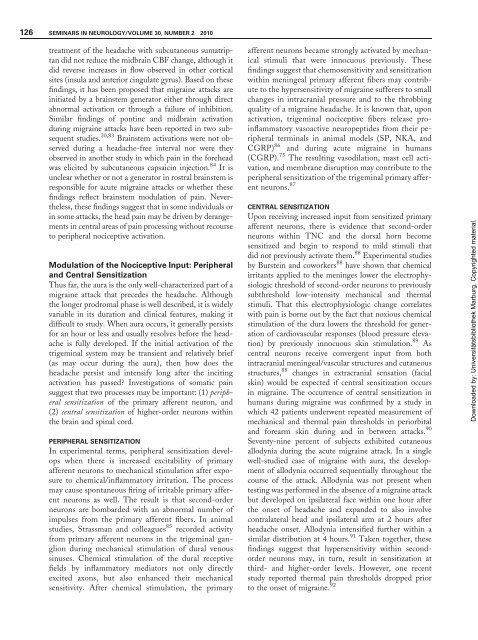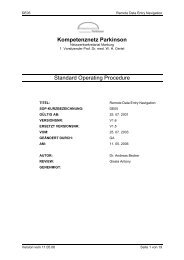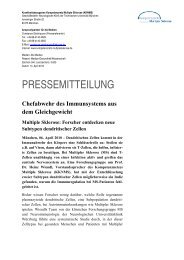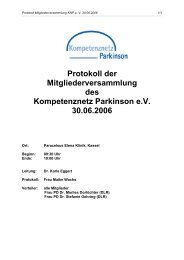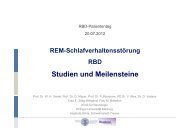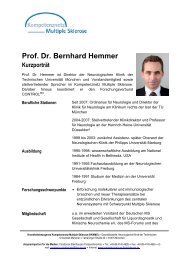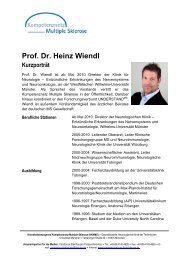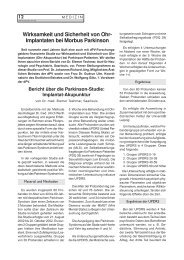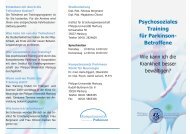Pathophysiology of Migraine - Kompetenznetz Parkinson
Pathophysiology of Migraine - Kompetenznetz Parkinson
Pathophysiology of Migraine - Kompetenznetz Parkinson
Create successful ePaper yourself
Turn your PDF publications into a flip-book with our unique Google optimized e-Paper software.
126 SEMINARS IN NEUROLOGY/VOLUME 30, NUMBER 2 2010<br />
treatment <strong>of</strong> the headache with subcutaneous sumatriptan<br />
did not reduce the midbrain CBF change, although it<br />
did reverse increases in flow observed in other cortical<br />
sites (insula and anterior cingulate gyrus). Based on these<br />
findings, it has been proposed that migraine attacks are<br />
initiated by a brainstem generator either through direct<br />
abnormal activation or through a failure <strong>of</strong> inhibition.<br />
Similar findings <strong>of</strong> pontine and midbrain activation<br />
during migraine attacks have been reported in two subsequent<br />
studies. 20,83 Brainstem activations were not observed<br />
during a headache-free interval nor were they<br />
observed in another study in which pain in the forehead<br />
was elicited by subcutaneous capsaicin injection. 84 It is<br />
unclear whether or not a generator in rostral brainstem is<br />
responsible for acute migraine attacks or whether these<br />
findings reflect brainstem modulation <strong>of</strong> pain. Nevertheless,<br />
these findings suggest that in some individuals or<br />
in some attacks, the head pain may be driven by derangements<br />
in central areas <strong>of</strong> pain processing without recourse<br />
to peripheral nociceptive activation.<br />
Modulation <strong>of</strong> the Nociceptive Input: Peripheral<br />
and Central Sensitization<br />
Thus far, the aura is the only well-characterized part <strong>of</strong> a<br />
migraine attack that precedes the headache. Although<br />
the longer prodromal phase is well described, it is widely<br />
variable in its duration and clinical features, making it<br />
difficult to study. When aura occurs, it generally persists<br />
for an hour or less and usually resolves before the headache<br />
is fully developed. If the initial activation <strong>of</strong> the<br />
trigeminal system may be transient and relatively brief<br />
(as may occur during the aura), then how does the<br />
headache persist and intensify long after the inciting<br />
activation has passed? Investigations <strong>of</strong> somatic pain<br />
suggest that two processes may be important: (1) peripheral<br />
sensitization <strong>of</strong> the primary afferent neuron, and<br />
(2) central sensitization <strong>of</strong> higher-order neurons within<br />
the brain and spinal cord.<br />
PERIPHERAL SENSITIZATION<br />
In experimental terms, peripheral sensitization develops<br />
when there is increased excitability <strong>of</strong> primary<br />
afferent neurons to mechanical stimulation after exposure<br />
to chemical/inflammatory irritation. The process<br />
may cause spontaneous firing <strong>of</strong> irritable primary afferent<br />
neurons as well. The result is that second-order<br />
neurons are bombarded with an abnormal number <strong>of</strong><br />
impulses from the primary afferent fibers. In animal<br />
studies, Strassman and colleagues 85 recorded activity<br />
from primary afferent neurons in the trigeminal ganglion<br />
during mechanical stimulation <strong>of</strong> dural venous<br />
sinuses. Chemical stimulation <strong>of</strong> the dural receptive<br />
fields by inflammatory mediators not only directly<br />
excited axons, but also enhanced their mechanical<br />
sensitivity. After chemical stimulation, the primary<br />
afferent neurons became strongly activated by mechanical<br />
stimuli that were innocuous previously. These<br />
findings suggest that chemosensitivity and sensitization<br />
within meningeal primary afferent fibers may contribute<br />
to the hypersensitivity <strong>of</strong> migraine sufferers to small<br />
changes in intracranial pressure and to the throbbing<br />
quality <strong>of</strong> a migraine headache. It is known that, upon<br />
activation, trigeminal nociceptive fibers release proinflammatory<br />
vasoactive neuropeptides from their peripheral<br />
terminals in animal models (SP, NKA, and<br />
CGRP) 86 and during acute migraine in humans<br />
(CGRP). 75 The resulting vasodilation, mast cell activation,<br />
and membrane disruption may contribute to the<br />
peripheral sensitization <strong>of</strong> the trigeminal primary afferent<br />
neurons. 87<br />
CENTRAL SENSITIZATION<br />
Upon receiving increased input from sensitized primary<br />
afferent neurons, there is evidence that second-order<br />
neurons within TNC and the dorsal horn become<br />
sensitized and begin to respond to mild stimuli that<br />
did not previously activate them. 88 Experimental studies<br />
by Burstein and coworkers 88 have shown that chemical<br />
irritants applied to the meninges lower the electrophysiologic<br />
threshold <strong>of</strong> second-order neurons to previously<br />
subthreshold low-intensity mechanical and thermal<br />
stimuli. That this electrophysiologic change correlates<br />
with pain is borne out by the fact that noxious chemical<br />
stimulation <strong>of</strong> the dura lowers the threshold for generation<br />
<strong>of</strong> cardiovascular responses (blood pressure elevation)<br />
by previously innocuous skin stimulation. 89 As<br />
central neurons receive convergent input from both<br />
intracranial meningeal/vascular structures and cutaneous<br />
structures, 88 changes in extracranial sensation (facial<br />
skin) would be expected if central sensitization occurs<br />
in migraine. The occurrence <strong>of</strong> central sensitization in<br />
humans during migraine was confirmed by a study in<br />
which 42 patients underwent repeated measurement <strong>of</strong><br />
mechanical and thermal pain thresholds in periorbital<br />
and forearm skin during and in between attacks. 90<br />
Seventy-nine percent <strong>of</strong> subjects exhibited cutaneous<br />
allodynia during the acute migraine attack. In a single<br />
well-studied case <strong>of</strong> migraine with aura, the development<br />
<strong>of</strong> allodynia occurred sequentially throughout the<br />
course <strong>of</strong> the attack. Allodynia was not present when<br />
testing was performed in the absence <strong>of</strong> a migraine attack<br />
but developed on ipsilateral face within one hour after<br />
the onset <strong>of</strong> headache and expanded to also involve<br />
contralateral head and ipsilateral arm at 2 hours after<br />
headache onset. Allodynia intensified further within a<br />
similar distribution at 4 hours. 91 Taken together, these<br />
findings suggest that hypersensitivity within secondorder<br />
neurons may, in turn, result in sensitization at<br />
third- and higher-order levels. However, one recent<br />
study reported thermal pain thresholds dropped prior<br />
to the onset <strong>of</strong> migraine. 92<br />
Downloaded by: Universitätsbibliothek Marburg. Copyrighted material.


